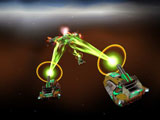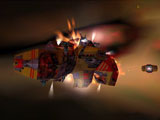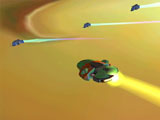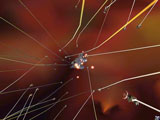 Most of reviews of Homeworld: Cataclysm have been very
enthusiastic. Critics are heralding it as
the next-best-thing to the Second Coming in Real Time Strategy games, and while I would
normally like to launch a vitriolic attack on something so many others like (call me
perverse), in this case that isn’t possible. Cataclysm
is a damn fine game. It’s immersive,
difficult, and carries more micro-management opportunities (the strength, in my opinion of
all good RTS games) than anything I’ve seen to-date.
It’s so good, in fact, that many won’t want to play it. Most of reviews of Homeworld: Cataclysm have been very
enthusiastic. Critics are heralding it as
the next-best-thing to the Second Coming in Real Time Strategy games, and while I would
normally like to launch a vitriolic attack on something so many others like (call me
perverse), in this case that isn’t possible. Cataclysm
is a damn fine game. It’s immersive,
difficult, and carries more micro-management opportunities (the strength, in my opinion of
all good RTS games) than anything I’ve seen to-date.
It’s so good, in fact, that many won’t want to play it.  The
story begins 15 years after the first Homeworld game ended.
The Kushans have successfully made a life for themselves on their ancient
homeworld Hiigara after a traumatic exodus from the planet Kharak during which that planet
was vaporized. You belong to kiith Somtaaw, a
mining clan that was decimated on the trip from Kharak.
Those kiiths that survived with more members dominate Hiigarin politics. However Somtaaw is has produced a new deep-space
mining vessel and, coupled with their engineering skill, the future looks bright. Don’t think you’ll get to pursue
economic advantage for long because a techno-bio-something virus called The Beast -- which
fights by assimilating enemy ships -- comes out of deep space and threatens your new
world. Hell, they threatens the whole galaxy
as well as the new fall television lineup. The
Beast is an interesting cross between the Zerg, Borg, and Wallmart, expanding into new
territories and taking over the competition, all while providing fast-efficient service. That’s the setup. Now comes the killing. The
story begins 15 years after the first Homeworld game ended.
The Kushans have successfully made a life for themselves on their ancient
homeworld Hiigara after a traumatic exodus from the planet Kharak during which that planet
was vaporized. You belong to kiith Somtaaw, a
mining clan that was decimated on the trip from Kharak.
Those kiiths that survived with more members dominate Hiigarin politics. However Somtaaw is has produced a new deep-space
mining vessel and, coupled with their engineering skill, the future looks bright. Don’t think you’ll get to pursue
economic advantage for long because a techno-bio-something virus called The Beast -- which
fights by assimilating enemy ships -- comes out of deep space and threatens your new
world. Hell, they threatens the whole galaxy
as well as the new fall television lineup. The
Beast is an interesting cross between the Zerg, Borg, and Wallmart, expanding into new
territories and taking over the competition, all while providing fast-efficient service. That’s the setup. Now comes the killing.
 Gameplay in Cataclysm is deep and complex. In a mission-based format, you’re in charge
of a fleet consisting of everything from small strike fighters to a huge command vessel
responsible for producing all of your machines. In
other RTS games, your production center – village, base, whatever – is usually
stationary and consists of multiple independent structures, and I like the singular,
mobile production facility in Cataclysm. In
addition to manufacturing corvettes and carriers in order to pulverize The Beast into
poker chips, you also need to mine recourses from asteroids and nebulas (you lose ships
like car keys) and research new technologies (The Beast is devious and requires
innovation). Throw in the control of a
massive number of ships, and you’ve got the initial daunting feel of this game. Luckily, the game interface is simply and
accessible from any of various tactical views available via both hotkeys and drop-down
menus, and the tutorial is excellent. Ships
can also fend for themselves once you set their combat profile, patrol routes, and
formations. However, while the artificial
intelligence is good, managing this many ships in a huge 3D environment takes some doing. Gameplay in Cataclysm is deep and complex. In a mission-based format, you’re in charge
of a fleet consisting of everything from small strike fighters to a huge command vessel
responsible for producing all of your machines. In
other RTS games, your production center – village, base, whatever – is usually
stationary and consists of multiple independent structures, and I like the singular,
mobile production facility in Cataclysm. In
addition to manufacturing corvettes and carriers in order to pulverize The Beast into
poker chips, you also need to mine recourses from asteroids and nebulas (you lose ships
like car keys) and research new technologies (The Beast is devious and requires
innovation). Throw in the control of a
massive number of ships, and you’ve got the initial daunting feel of this game. Luckily, the game interface is simply and
accessible from any of various tactical views available via both hotkeys and drop-down
menus, and the tutorial is excellent. Ships
can also fend for themselves once you set their combat profile, patrol routes, and
formations. However, while the artificial
intelligence is good, managing this many ships in a huge 3D environment takes some doing.
Cataclysm sports an interesting
variety of ships from the mimic, which takes on the appearance of enemy ships and
asteroids (vital in many missions), to the hive frigate (has a small number of attack
ships that swarm a target), to the dreadnought battle cruiser (just about as tough as it
sounds). Producing an effective fleet is a
real challenge both because your command ship supports a limited number of vessels and the
huge number of possible fleet configurations. You
really need to tailor a fleet to each mission, but production is fast and changing your
available ships isn’t a big deal.
 The dynamic mission bases system both intrigued me and produced
headache-level frustration. Starting out,
your mission objective is about as solid as hot cheese.
Objectives fluctuate and change, so there’s no telling where the enemy
is coming from or what you’re really going to need to do. On the one hand, this adds narrative power and
suspense as well as a healthy dose of realism. Actual
combat, I suppose, must fluctuate and shift as new information come available. On the other, I had to play every mission like a
dog about to be kicked, moving my ships out cautiously with the sure knowledge that, once
I figured out the scenario, I’d have to restart the mission. And restart.
And restart. This moves
Cataclysm into the for-hardcore-gamers-only category. The dynamic mission bases system both intrigued me and produced
headache-level frustration. Starting out,
your mission objective is about as solid as hot cheese.
Objectives fluctuate and change, so there’s no telling where the enemy
is coming from or what you’re really going to need to do. On the one hand, this adds narrative power and
suspense as well as a healthy dose of realism. Actual
combat, I suppose, must fluctuate and shift as new information come available. On the other, I had to play every mission like a
dog about to be kicked, moving my ships out cautiously with the sure knowledge that, once
I figured out the scenario, I’d have to restart the mission. And restart.
And restart. This moves
Cataclysm into the for-hardcore-gamers-only category.
 If punishing space-plagues isn’t enough, Cataclysm has
excellent graphics. The ship details are
great (although The Beast ships ought to be a little more scary) and the textures look
nice. Unfortunately, the in-mission
cut-scenes and between-mission movies are terrible. In-mission,
the camera is static and doesn’t take advantage of the three dimensions. Between-missions, the films are in black and
white, again static, and dull. Voice acting,
while good in parts (i.e.: in-mission alerts and combat chatter), suffers as well. It’s a little sad that such a pretty game to
play doesn’t have equally pretty cinematics. If punishing space-plagues isn’t enough, Cataclysm has
excellent graphics. The ship details are
great (although The Beast ships ought to be a little more scary) and the textures look
nice. Unfortunately, the in-mission
cut-scenes and between-mission movies are terrible. In-mission,
the camera is static and doesn’t take advantage of the three dimensions. Between-missions, the films are in black and
white, again static, and dull. Voice acting,
while good in parts (i.e.: in-mission alerts and combat chatter), suffers as well. It’s a little sad that such a pretty game to
play doesn’t have equally pretty cinematics.
Cataclysm deserves all of the good
reviews it’s garnered. I haven’t
played an RTS this demanding before and all of those who loved the first Homeworld will
not be disappointed in the follow-up. Completing
a single mission in Cataclysm is an accomplishment what with the complex battle scenarios
and the simple necessity for strategic depth on the part of the player. But, that type of challenge will discourage some
players and, for the more casual gamer, there isn’t much beyond tedious replay. That, coupled with poor film sequences, stops
Cataclysm from getting a perfect review. It’s
a fantastic game, but a fantastic game that I wouldn’t recommend to everybody.
--Matt
Blackburn |

 Most of reviews of Homeworld: Cataclysm have been very
enthusiastic. Critics are heralding it as
the next-best-thing to the Second Coming in Real Time Strategy games, and while I would
normally like to launch a vitriolic attack on something so many others like (call me
perverse), in this case that isn’t possible. Cataclysm
is a damn fine game. It’s immersive,
difficult, and carries more micro-management opportunities (the strength, in my opinion of
all good RTS games) than anything I’ve seen to-date.
It’s so good, in fact, that many won’t want to play it.
Most of reviews of Homeworld: Cataclysm have been very
enthusiastic. Critics are heralding it as
the next-best-thing to the Second Coming in Real Time Strategy games, and while I would
normally like to launch a vitriolic attack on something so many others like (call me
perverse), in this case that isn’t possible. Cataclysm
is a damn fine game. It’s immersive,
difficult, and carries more micro-management opportunities (the strength, in my opinion of
all good RTS games) than anything I’ve seen to-date.
It’s so good, in fact, that many won’t want to play it.